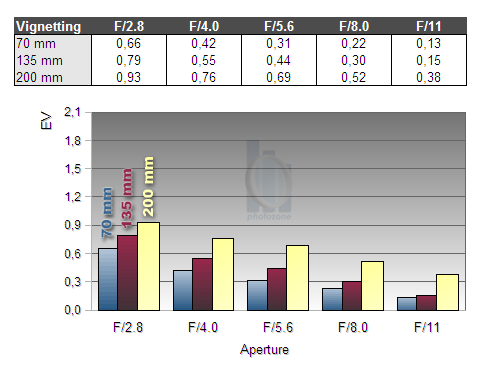|
Nikkor AF-S 70-200mm f/2.8 G ED VR II (FX) - Review / Test Report - Analysis |
|
Lens Reviews -
Nikon / Nikkor (full format)
|
|
Page 2 of 3

Distortion
The lens shows distortion characteristics that are typical for this lens class. At the short end there is a slight amount of barrel distortion which flips over to around 1% pincushion distortion at 135 mm and just above 1.4% at 200 mm. This may be an issue with some critical subjects. However, the good news is that it is a uniform distortion that is not too complicated to correct by software during image post processing.
|
Move the mouse cursor over the focal length text marks below to observe the respective distortions
|
| 70mm |
135mm |
200mm |
|

|
The chart above has a real-world size of about 120x80cm.
Vignetting
Fast zoom lenses tend to have some vignetting problems on FX cameras. However, the issue is well under control at all focal lengths. There is, of course, some visible vignetting at wide open aperture but at an amount of less 1 EV it's probably not an issue for the subject you'd shoot with a fast tee prime at these apertures. Stopping down helps to reduce the vignetting to an amount that's hardly field relevant anymore.
We're performing our vignetting analysis based on
(uncorrected) JPEGs straight from the camera. The JPG engine of the Nikon D3x features a rather flat
gradation curve, thus has a moderate contrast characteristic, resulting in comparatively low vignetting figures - the
corresponding Canon figures are roughly 40% higher due to the more
aggressive default contrast setting.

MTF (resolution)
The lens delivers an excellent sharpness in the image center at all focal lengths and all apertures till diffraction kicks in at f/11 (as usual). The borders and extreme corners follow a little behind but deliver very good resolution. At 70mm and 135mm the sharpness drops by around one school mark at f/2.8. However, the situation improves again at 200mm.
The tested sample was well centered.
Please note that the MTF results are not directly comparable across the different systems!
Below is a simplified summary of the formal findings. The chart shows line widths
per picture height (LW/PH) which can be taken as a measure for sharpness.
If you want to know more about the MTF50 figures you may check out the corresponding
Imatest Explanations

Chromatic Aberrations (CAs)
Chromatic aberrations (color shadows at harsh contrast transitions) are moderate at 70mm but slightly higher at 135mm and 200mm with an amount of up to 1.5 pixels. Please note that lateral CAs can easily be corrected in software or by the camera itself (most modern Nikon DSLRs remove CAs on-the-fly if you shoot JPGs).

Bokeh
Being a fast tele lens one of the lens' welcome abilities is to separate the main subject from the background so rendering of out of focus areas is an important aspect.The 70-200 VR II delivers a generally very smooth bokeh at all focal lengths with just a minor amount of nervousness in the transition (see the crop of the "king" below).
Thanks to 9 rounded aperture blades background highlights remain circular throughout the whole aperture and focal range. They show a smooth filling with almost no outlining.
|
Move the mouse cursor over the focal length text marks below to observe the respective bokeh
|
| 70mm |
135mm |
200mm |
|

|
Bokeh Fringing / Longitudinal Chromatic Aberrations (LoCA)
LoCAs (non-coinciding focal planes of the various colors) are a common issue with relatively fast glass. As you can
notice below the halos have different colors - magenta (red + blue) in front the focus point
and green beyond. Truly "apochromatic" lenses don't show LoCAs but these lenses are very rare. Unlike lateral CAs LoCAs cannot easily be fixed during post processing.
At it longest focal length of 200 mm (which we used for the shots below) the lens shows a moderate amount of LoCAs wide open, which is considerably reduced by f/4 already and no longer field relevant at f/5.6 and beyond.
|